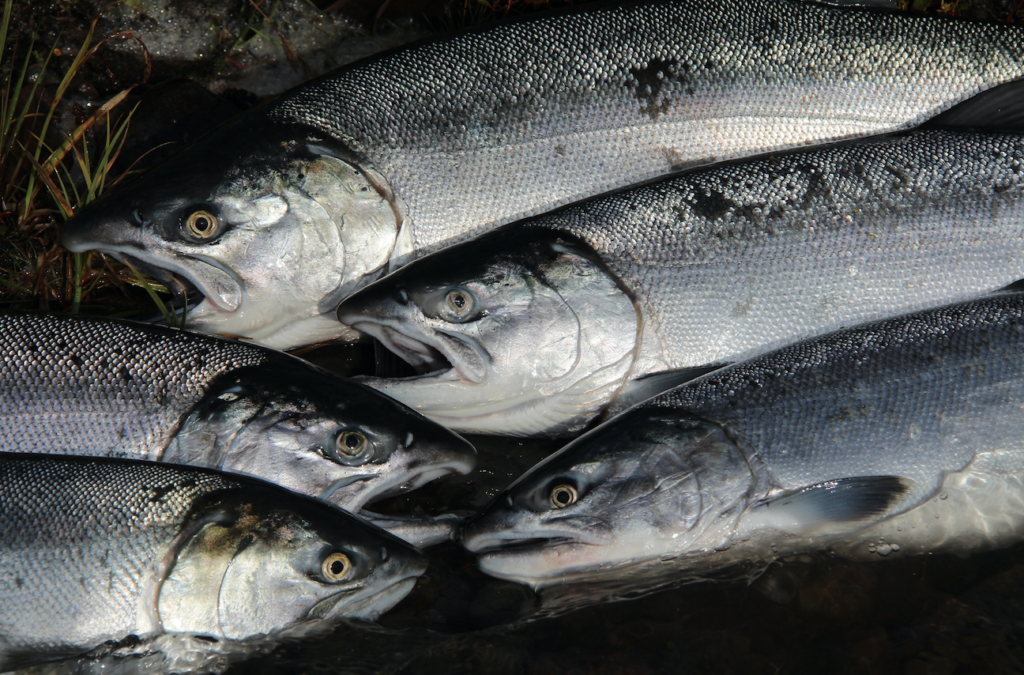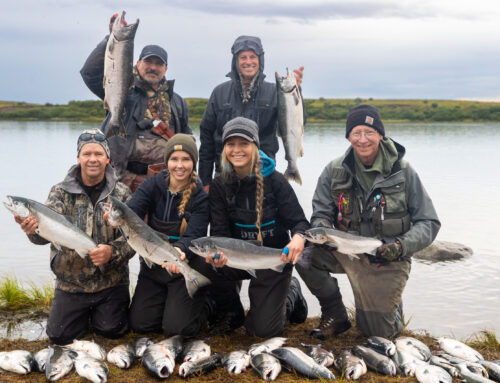At Becharof Lodge, we’re fortunate to be situated on the banks of the beautiful Egegik River. The Egegik River in remote Alaska is a clear, shallow river with a gravel bottom that holds a lot of fish.
While we get many fish species in the Egegik River, starting in August, coho salmon are on the menu. As these fish, also known as silver salmon, make their way up the river, by our camp, and into Becharof Lake en route to spawning locations, we fish for them many different ways.
On the Egegik River, south of King Salmon, Alaska, we can fish with bait, so cured salmon eggs are a favorite approach of many anglers. Others prefer casting lures, while others enjoy flyfishing for salmon. If you like flyfishing, you’ll love fishing poppers. There’s nothing in the world of salmon fishing like having a 15-pound coho rise to the surface, attack your popper, and take off on a hellacious run through the shallows.
Here are a few ways we fish surface poppers for coho salmon. Whether you’re fishing with us, or anywhere else in Alaska for silver salmon, give these approaches a try, you’ll be glad you did!
Dead-Drifting Poppers
Silver salmon do a large part of their traveling at night, and even with limited darkness in August and September, fish move then congregate in less taxing waters during the early morning hours. If the morning is cloudy, that’s even better for keeping coho stacked in slack water settings, for longer periods of time. This is the ideal water to hit early in the morning, before the sun comes up and prior to fellow bank anglers–and boat traffic on larger rivers–forcing fish to move.
This is also the perfect situation for dead-drifting a surface popper. Early in the morning, aggressive ripping and chugging can spook coho in calm waters, sending them deep rather than enticing them to the surface. In this case, less popper action can yield more strikes.
Once spooked, it’s hard getting salmon to cooperate, especially in crystal clear water. Think stealth, cover water close to shore, don’t get in a hurry, and you’ll find success on silvers holding close to shore and in slack water early in the day. Simply cast out, let out more line, keep mending it, and let the current carry the presentation downstream. Refrain from casting, especially false casting, which can alert wily salmon and turn off the bite.

Swing & Strip Poppers
Later in the morning, as sunlight hits the water, or when fishing fast, choppy water, swing and strip those poppers. When there’s enough chop on the surface to offer coho salmon the comfort they need to keep them holding along the main current lines, the stage is set for a more aggressive presentation.

The aggressive action of swinging and stripping a popper will catch the attention of coho holding in the current, and when chugged hard enough, will entice them to strike. Having an eager coho turn on the popper in fast water means you better be ready and have a good drag, as it’s a far different take and battle than a slack water, boiling strike, where a fish is hooked then moves into faster water.
Over the decades, we’ve learned that during the middle of the day, generally speaking, silver salmon either hold in fast moving currents in shallow streams, or deep holes in big rivers. In shallow, fast flowing, choppy water in small to mid-sized streams and braided rivers, poppers can produce incredible strikes.
When stripping a popper through fast water, properly positioning the setup is key. Cast too far downstream and you miss the prime water; cast too high above the sweet spot and you cross it too soon. Once you’ve identified where coho will likely hold, pay attention to water flow and surface action and observe how they will impact your line and popper as they move downstream. Be ready to make adjustments accordingly, like quickly feeding out some line, mending it, or stripping line in order to get the presentation into position for quicker strips that will produce attention-getting chugs.
When aggressively stripping poppers through fast water, the outside edge of the main current is the target zone. This is where the most aggressive coho will travel to and strike, first. If the strike doesn’t come there, the moment the popper enters the main current, hold the line, bring the rod tip to the inside and swing the popper to the insides edge of the main current. As the popper hits the main current, holding the line will create a constant wake that often entices coho to attack.
If a hit doesn’t come on the swing through the main current or the inside edge, keep the line moving toward the inside. As the popper loses momentum due to  decreased current flow, start stripping. Even if the coho aren’t holding on the inside seam, the popping action will often draw them from out of the main current. It’s not uncommon to have a coho follow the popper for several yards, attacking it at your feet, just as you go to pull it out of the water.
decreased current flow, start stripping. Even if the coho aren’t holding on the inside seam, the popping action will often draw them from out of the main current. It’s not uncommon to have a coho follow the popper for several yards, attacking it at your feet, just as you go to pull it out of the water.
In long sections of fast flowing riffles, start at the top and work your way to the bottom end. This distance may be 10 yards, it may be 100 yards, depending on the gradient of the river, bottom structure and water level, which dictate where coho will hold.
If you hit coho in certain spots in fast moving riffles, then the bite turns off, go back through the same water with a subsurface presentation. A Wog or flashy leach can be the ticket to turning the bite back on. Often the fish are there, you just have to find what appeals to them at different times in the day, when fishing pressure and direct light can factor in to their response rates.






